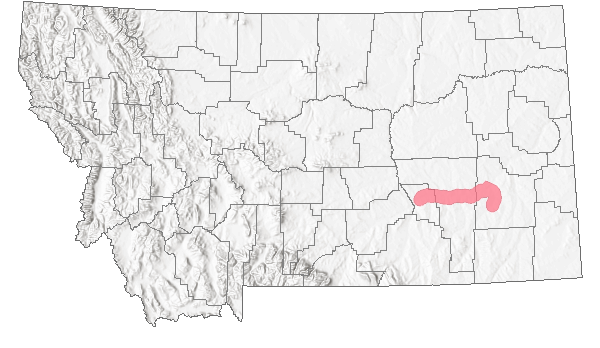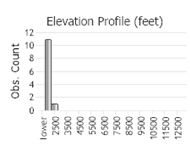View in other NatureServe Network Field Guides
NatureServe
Montana
Utah
Wyoming
Idaho
Wisconsin
British Columbia
South Carolina
Yukon
California
New York
Mapleleaf - Quadrula quadrula
General Description
The Mapleleaf is a relatively common mussel in the Missouri and Mississippi River drainage's of North America, and has been recently introduced into MT's Tongue River and Lower Yellowstone River, likely from catfish or crappie stocking. It can be found as far south as the Tennessee River, throughout the Midwest and Plains States (native in SD, ND). The Mapleleaf prefers pools of sluggish streams with a mud, sand, or fine gravel bottom. Known host fish species include the Common Carp, Catfish, Green Sunfish, White Crappie, 3 of these 4 species are introduced or exotic species in Montana. Mapleleafs have a fairly thick shell with well-developed teeth. Squared in outline, lateral surface with two rows of pustules separated by a sulcus.
Species Range
Montana Range
Range Descriptions

 Non-native
Non-native
Observations in Montana Natural Heritage Program Database
Number of Observations: 13
(Click on the following maps and charts to see full sized version)
Map Help and Descriptions
Relative Density

Recency



 (Observations spanning multiple months or years are excluded from time charts)
(Observations spanning multiple months or years are excluded from time charts)
Migration
Sedentary as adults, rarely move more than a few meters. As larvae (glochidia on the fish gills), they use their fish host for disperal upstream or downstream to other suitable habitats.
Habitat
Medium to large rivers and reservoirs with a mud, sand, or gravel bottom.
Food Habits
Freshwater mussels are mostly filter-feeders, siphoning in floating particulate organic materials (small plant or animal) from the water column and straining out the particles and expel the strained water. Pedal feeding with the foot muscle has also been observed, mostly in juveniles and younger age-classes.
Stewardship Responsibility
Threats or Limiting Factors
Threats to freshwater mussels and their habitats are thought to include: Pollution, Diversion of rivers for irrigation, hydroelectric and water supply projects, Elimination of natural fish hosts, Eutropification due to agricultural runoff and urbanization
References
- Web Search Engines for Articles on "Mapleleaf"
- Additional Sources of Information Related to "Mussels / Clams"





